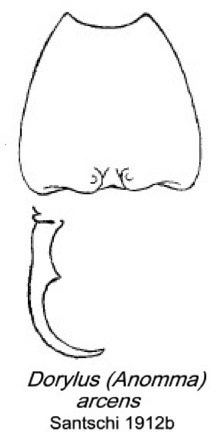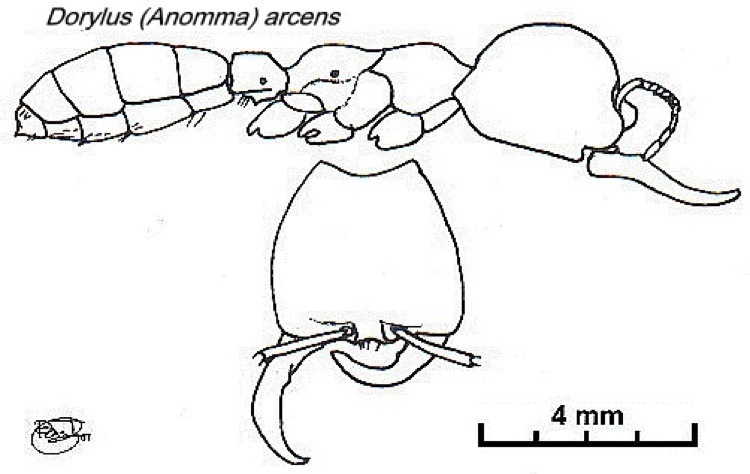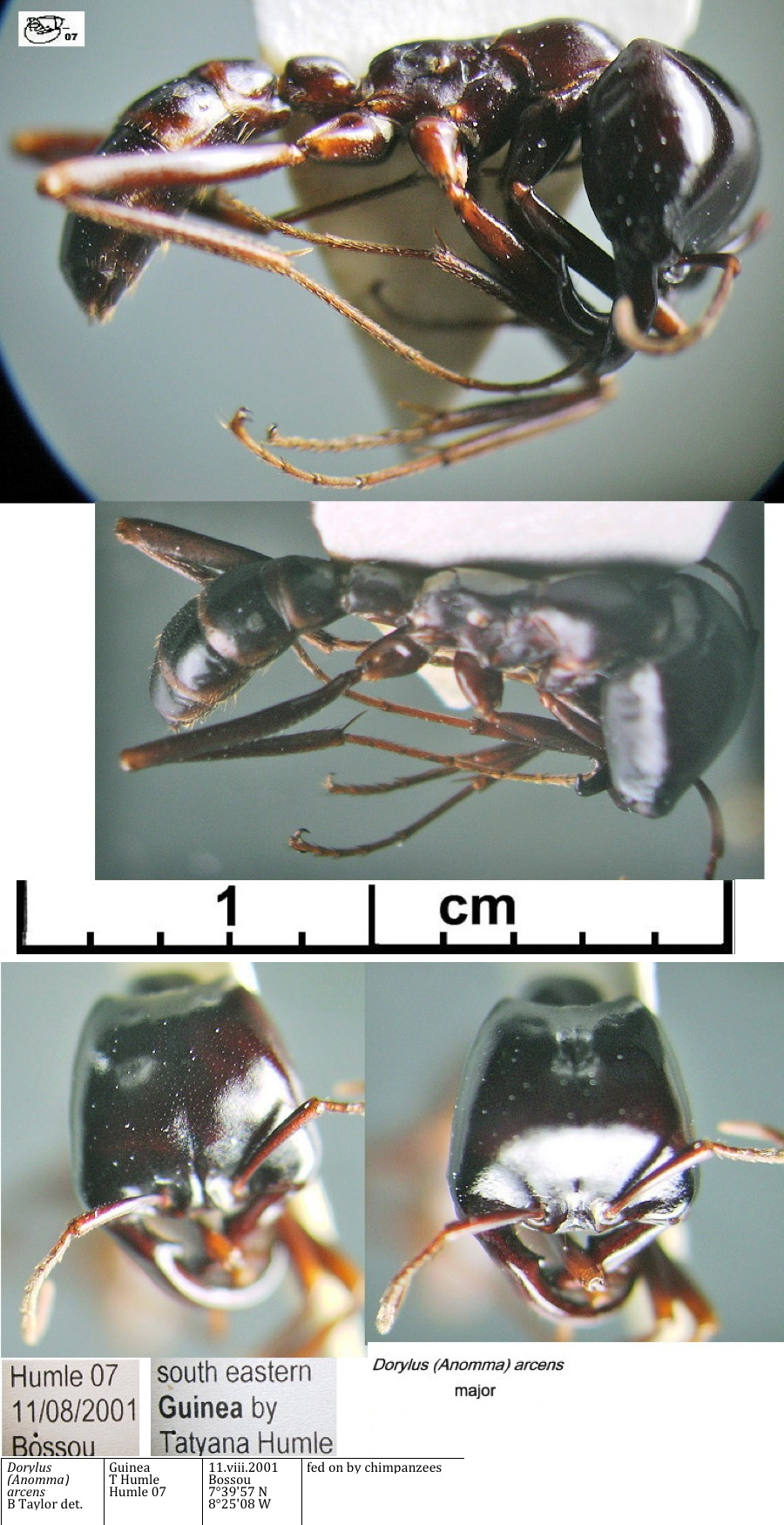Dorylus (Anomma) arcens (Westwood)
  Type location Liberia
(Anomma arcens, Westwood, 1847b: 16, illustrated, worker;
describing the ants in the paper by T.S. Savage, 1847, from Cape
Palmas; also illustrated by Santschi, 1912b: 155) - see linked worker
page (media worker) Type location Liberia
(Anomma arcens, Westwood, 1847b: 16, illustrated, worker;
describing the ants in the paper by T.S. Savage, 1847, from Cape
Palmas; also illustrated by Santschi, 1912b: 155) - see linked worker
page (media worker)
junior synonym pubescens
(Anomma pubescens n. sp., Roger, 1861a: 47, worker; synonymy by
Emery, 1895j: 710) from Liberia - no images on Antweb (June
2014)  . .
|
 Westwood's
(1849) description, as published in Savage
(1849), is at Westwood's
(1849) description, as published in Savage
(1849), is at  . Santschi (1912b, as D. A. nigricans Ill. stirps arcens West.) had
notes, these are at . Santschi (1912b, as D. A. nigricans Ill. stirps arcens West.) had
notes, these are at  . Haldeman's (1849a)
paper
on Savage's collection of rubella "red drivers" from Gabon,
noted that "the abdominal peduncle [petiole] in arcens is
slightly smaller than in rubella. ... arcens [from
Liberia] being black"; this is at . Haldeman's (1849a)
paper
on Savage's collection of rubella "red drivers" from Gabon,
noted that "the abdominal peduncle [petiole] in arcens is
slightly smaller than in rubella. ... arcens [from
Liberia] being black"; this is at  . Roger's (1861a)
description of pubescens minor workers is at . Roger's (1861a)
description of pubescens minor workers is at  . .
Santschi (1930a: 55) described what he regarded as the
soldier & worker of "nigricans" from Mali (Bamakou,
by Andrieu); this is at  .
As with other authors, he did not see either a queen or male and noted
only small differences from burmeisteri soldiers and workers.
He pointed out that nigricans s.s. was
known only from the
male. Now (July 2014) images of his "type" workers, a major and media
4, have become available on Antweb and, as shown on my linked workers
page, they turn out to exactly match the Westwood types and the fresh
specimens. .
As with other authors, he did not see either a queen or male and noted
only small differences from burmeisteri soldiers and workers.
He pointed out that nigricans s.s. was
known only from the
male. Now (July 2014) images of his "type" workers, a major and media
4, have become available on Antweb and, as shown on my linked workers
page, they turn out to exactly match the Westwood types and the fresh
specimens.
|
Wheeler (1922) remarked upon specimens that he thought
were of the subspecies arcens, as being very dark almost black,
the specimens were no more than 10.5 mm long, whereas "the largest
workers, according to Emery and Santschi, measure 13 mm". The surface
of the body is very shining the head more opaque in front. He described
subspecies sjoestedti as like burmeisteri in having the
inferoposterior angles of the petiole prolonged outwards as distinct
tubercles but readily distinguished by having the heads of the larger
workers (7.5 to 12 mm) opaque instead of shining and that of the
smaller workers elongate.
Raignier & van Boven (1955) remarked that the
original descriptions by Westwood (1847-1849) did not give them any
unequivocal characteristics. Westwood laid an emphasis on the petiole
having small posterior ventral and laterally flared lobes. This they
found, from many specimens in Yangambi, to be very variable among the
several subspecies and varieties of nigricans. Roger (1861)
found specimens from Angola to have characters of both burmeisteri
and arcens. Emery (1891) noted, however, that arcens had
the characteristic form with the head strongly narrowed behind and with
pointed angles; with a stronger sculpture giving the head a matt
aspect. On the other hand burmeisteri had the sides of the head
more arcuate and the posterior angles less acute, more rounded; the
fine reticulate punctuation more superficial and leaving the head quite
shiny in the posterior part. Also, arcens was more robust, with
the mandibles more strongly arcuate. Raignier & van Boven commented
that the variability they had observed rendered this separation on
levels of strength of sculpturation unsound. In their examination of
specimens they collected at Yangambi, they did not encounter any they
denoted as arcens, although Collection 21b, of "burmeisteri
var. terrificus" had the form of the head - with the posterior
angles rounded and the cheeks convex, CI about 106 - as typical of
either arcens or terrificus but the colour was too
bright for arcens and they plumped for terrificus, with
the cheeks rounded and the rear of the head shiny. I found their
comments confusing as they cited the description of terrificus
by Santschi (1923) - differing from burmeisteri in being more
robust; the head of the major is large and trapezoidal; the sides are
more convex, as with arcens, although the funiculus segments
are more clearly longer as in burmeisteri; the head is glabrous
and shiny, except the anterior which is semi-matt; the petiole has the
same form as burmeisteri. Raignier & van Boven commented,
however, that two specimens in the Royal Congo Museum, apparently
determined by Santschi, had heads which are entirely matt.
Thus, here, I have opted for arcens as being the
species with a totally matt head. The Dorylus
terrificus specimens have the much shinier appearance and the
long funiculus
segments.
Wheeler (1922) listed findings from Sierra Leone
(Kortright Hill, by W.G. Clements); Ivory Coast (by Lohier, and
at Assinie by C. Alluaud); Ghana (Gold Coast, Aburi by F.
Silvestri); Congo (French Congo, Fort Crampel by Schubotz;
Brazzaville, by A. Weiss); Gabon; Zaïre (Medje, Lang
& Chapin).
Three forms were found in Guinea (Bernard,
1952). Typical form, dark red, head often black, abundant at N'Zo, 500
m, several workers at Yanlé (station F19). ssp. arcens, black
and more matt, head more convex, large worker from Yalanzou, purely a
western form. ssp. burmeisteri red and matt, more widespread,
reaching 2400 m, at the peak of Fernando Po - Lamotte took several
minor workers in his transects but never found a colony; common at
Yanlé, Nion, N'Zo (rare), Camp I of Mount Tô (1600 m, abundant).
|
Oxford University Museum
specimens. Note
the Liberia workers were from a single swarm from pitfall traps at 10 m
intervals, so the swarm covered a diameter of at least 120 m. Several
traps contained well over 100 specimens
Dorylus (Anomma) arcens
B Taylor det.
|
Guinea
T Humle
Humle 07
|
11.viii.2001
Bossou
7°39'57 N
8°25'08 W
|
fed on by chimpanzees
|
5
|
 |
Dorylus (Anomma) arcens
B Taylor det. |
Liberia
E Poirier
Yekepa
PF 1
|
29.iii.2013
Nimba County
07°33’38" N
08°32’33" E
|
Pitfall trap
Degraded secondary forest
518 m asl
major
|
1
|
 |
Dorylus (Anomma) arcens
B Taylor det. |
Liberia
E Poirier
Yekepa
PF 2
|
29.iii.2013
Nimba County
07°33’38" N
08°32’33" E
|
Pitfall trap
Degraded secondary forest
518 m asl
major
|
1
|
 |
Dorylus (Anomma) arcens
B Taylor det. |
Liberia
E Poirier
Yekepa
PF 3
|
29.iii.2013
Nimba County
07°33’38" N
08°32’33" E
|
Pitfall trap
Degraded secondary forest
518 m asl
major & minima
|
2
|
 |
Dorylus (Anomma) arcens
B Taylor det. |
Liberia
E Poirier
Yekepa
PF 4
|
29.iii.2013
Nimba County
07°33’38" N
08°32’33" E
|
Pitfall trap
Degraded secondary forest
518 m asl
major
|
1
|
 |
Dorylus (Anomma) arcens
B Taylor det. |
Liberia
E Poirier
Yekepa
PF 5
|
29.iii.2013
Nimba County
07°33’38" N
08°32’33" E
|
Pitfall trap
Degraded secondary forest
518 m asl
major & minima
|
2
|
 |
Dorylus (Anomma) arcens
B Taylor det. |
Liberia
E Poirier
Yekepa
PF 6
|
29.iii.2013
Nimba County
07°33’38" N
08°32’33" E
|
Pitfall trap
Degraded secondary forest
518 m asl
major
|
2
|
 |
Dorylus (Anomma) arcens
B Taylor det. |
Liberia
E Poirier
Yekepa
PF 7
|
29.iii.2013
Nimba County
07°33’38" N
08°32’33" E
|
Pitfall trap
Degraded secondary forest
518 m asl
major
|
1
|
 |
Dorylus (Anomma) arcens
B Taylor det. |
Liberia
E Poirier
Yekepa
PF 8
|
29.iii.2013
Nimba County
07°33’38" N
08°32’33" E
|
Pitfall trap
Degraded secondary forest
518 m asl
major
|
1
|
 |
Dorylus (Anomma) arcens
B Taylor det. |
Liberia
E Poirier
Yekepa
PF 9
|
29.iii.2013
Nimba County
07°33’38" N
08°32’33" E
|
Pitfall trap
Degraded secondary forest
518 m asl
major
|
1
|
 |
Dorylus (Anomma) arcens
B Taylor det. |
Liberia
E Poirier
Yekepa
PF 10
|
29.iii.2013
Nimba County
07°33’38" N
08°32’33" E
|
Pitfall trap
Degraded secondary forest
518 m asl
major
|
11
|
 |
Dorylus (Anomma) arcens
B Taylor det. |
Liberia
E Poirier
Yekepa
PF 11
|
29.iii.2013
Nimba County
07°33’38" N
08°32’33" E
|
Pitfall trap
Degraded secondary forest
518 m asl
major
|
5
|
 |
Dorylus (Anomma) arcens
B Taylor det. |
Liberia
E Poirier
Yekepa
PF 12
|
29.iii.2013
Nimba County
07°33’38" N
08°32’33" E
|
Pitfall trap
Degraded secondary forest
518 m asl
major
|
5
|
 |
Dorylus (Anomma) arcens
B Taylor det. |
Liberia
E Poirier
Yekepa
PF 13
|
29.iii.2013
Nimba County
07°33’38" N
08°32’33" E
|
Pitfall trap
Degraded secondary forest
518 m asl
major
|
4
|
 |
|
 Nigeria specimens (as Dorylus species
A,
Taylor, 1978b: 15). WORKERS. TL 12.88-6.50 mm. Five morphs; largest HL
3.61, HW 3.80, SL 1.90, PW 1.52, petiole length 1.12 Nigeria specimens (as Dorylus species
A,
Taylor, 1978b: 15). WORKERS. TL 12.88-6.50 mm. Five morphs; largest HL
3.61, HW 3.80, SL 1.90, PW 1.52, petiole length 1.12
Colour red-brown, head darker, anteriorly near black; all morphs
similarly coloured. Erect hairs only on sternites and subpetiole. Head
massive, greatest width just before anterior margin, and a deeply
convex posterior margin; in profile with a very convex dorsum. Anterior
clypeal margin shallowly concave, only sparse short erect setae.
Mandibles with a very long apical tooth and a smooth inner margin to a
much reduced basal tooth, only much reduced setae on inner margin.
Antennal scapes narrow, parallel sided. Promesonotum with a near flat
dorsum. Propodeum near flat; spiracle ovoid vertically. Subpetiolar
process very broad based, a small anterior extension and a slightly
longer, triangular posterior extension.
Collected at the Cocoa Research Institute of Nigeria, Idi Ayunre, by B.
Bolton.
|
 Polymorphism Polymorphism
The photomontages are of specimens collected at Bossou,
south eastern Guinea by Tatyana Humle (Humle 7, 11.viii.2001).
The ant colony was observed as eaten by chimpanzees using the
"ant-dipping" (using tools to gather the ants). The heavy bulbous head
and mandible with no more than a small basal tooth and no other teeth
or denticles are characteristic.
|
|
The various morphs, with the type media
worker, are shown in detail
on the Dorylus (Anomma) arcens
morphs page.
|
 Full
new description - Humle 7 Full
new description - Humle 7
Overall - shiny matt very dark chestnut
TL 10.5 HW 3.5 HL 3.25 HD 2.45 CI 108 SL 1.75 SI 54 AL 3.5 PW 1.2 PetL
1.0 GL 4.25 MFL 2.75
Head - trapezoid, widest pre-anterior, posterior no more than 2/3 as
wide near straight, rear third angled inward; posterior margin more
shallow scallop but slight median outward bump, posterolateral angles
sharp; sculpturation of extremely fine spiculation, almost effaced on
posterior half of face, which has minute sparse hair pits; median line
visible only in some angles of light as a faint impression; clypeal
margin very shallow concave arc, no median hair, very fine pair away
from midpoint; mandible long and slender, with small basal tooth,
minute hair pits; scape moderately thick, broadening from base to apex,
near smooth; funiculus segments progressively lengthening and widening;
apex no more than 1/3 longer than 9; head in profile very bulbous,
posterior corners fairly acute angles; hairs barely visible @ 32x.
Alitrunk - in profile a shallow dome, near flat dorsally distinct
"saddle"; spiracle a vertical oval rearward facing; declivity higher
than others with incurve at bottom; metapleural gland with upper margin
distinctly longer than lower; all over fine spiculation, coarsening
rearward and downwards; hairs none.
Petiole - moderately long, flat dorsum, posterior face vertical and in
turned; dorsum basally widening front to back; spiracle small but
distinctly raised; subpetiolar process a moderately large rearward
facing triangle; sculpturation as alitrunk; hairs several below.
Gaster - all segments very finely spiculated like the head; waisted but
less so than others; hairs sparse on posterior margins, fine pilosity
on apical segments.
Legs - coxae moderately long but more rounded outer surface; femora
broad, very fine spiculation; tibiae moderately wide, coarse pilosity;
tarsae quite long, bristly, large claws.
|
 Minima
morph Minima
morph
Head densely spiculate, colour dark orange brown; lateral clypeus very
narrow; dorsum with fine decumbent pilosity. |
|